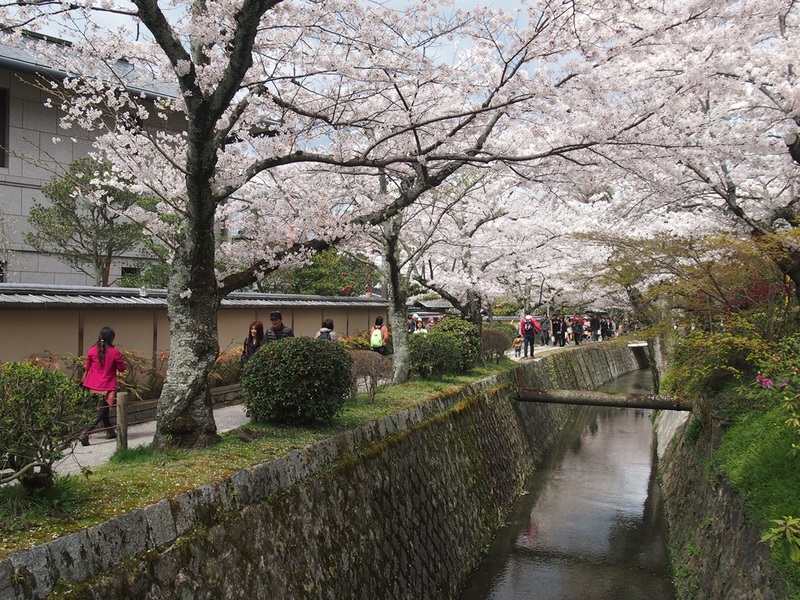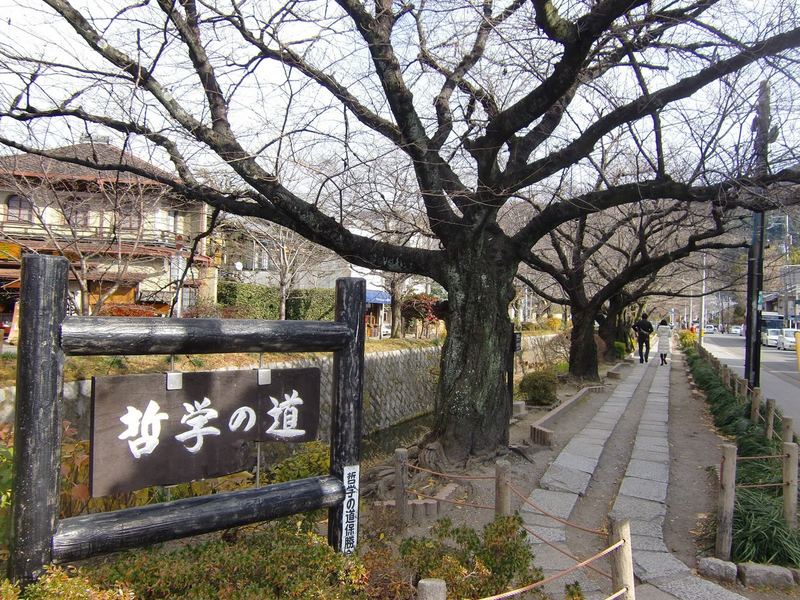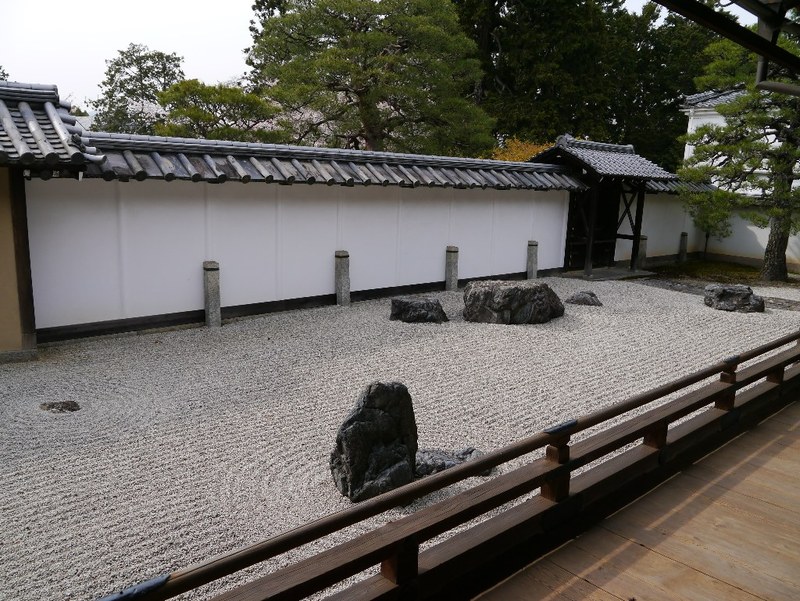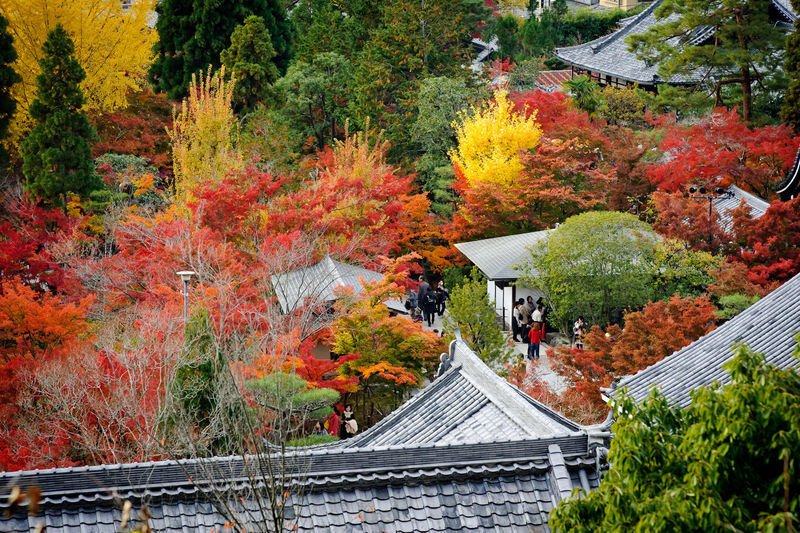Philosopher's Walk
This name refers to a narrow street that runs along a small canal surrounded by cherry trees in the north-east of the city, about 1 km and a half long.
Its name comes from the Japanese philosopher of the first half of the 'the 900th
Kitaro Nishida, who taught for several years at the University of Kyoto, and it is said he used to walk along this street during his moments of reflection.
The neighborhood
Doing a simple walk through this area as the philosopher Nishida used to do in the last century, especially in April when the cherry trees are in bloom, is already a great thing to do.

 the Philosopher's Walk in april
the Philosopher's Walk in april
Making small detours along the way, you can also visit various temples and shrines.
Moreover, at the ends of this path you can visit three of the most famous temples of Kyoto, that most of all worth a visit, the
Ginkakuji temple in the north end and the
Nanzenji and
Eikando temples in the south end.
Ginkakuji Temple
(admission 500 yen, opening hours 8:30-17, 9-16:30 dec-feb)
This temple, whose official name is
Jishoji, but commonly known as Ginkakuji (literally "Temple of the Silver Pavilion"), was built in 1482 as a reproduction of the famous Kinkakuji (see
Northern Kyoto).
The main building of the temple can not be visited, but the most famous building is right its
Padiglione d'argento, which in fact was never covered with silver and is thus presented as a normal wooden temple. This pavilion is the only building that survived the centuries and dates back to the period of the foundation of the temple, along with another small building (
Togudo).
The gardens of the temple are also very beautiful, in particular the rock gardens, which are among the most charming of the city.
From the back of the temple you can climb a path up a hill from where you can see an overview of Ginkakuji from above with the houses of Kyoto in the background.
It is one of the most visited temples in the city, then, if you can, go there in less popular days and hours in order to better enjoy the magic of this kind of places.
Nanzenji Temple
(opening hours 8:40-17, until 16:30 dec-feb)
One of the most important Zen Buddhist temples in Japan, it covers a large area with beautiful gardens.
You can have free access to the temple, while the entrance to some buildings has an entrance fee, in particular to the entrance gate (
Sanmon, 500 YEN) and to the main building (
Hojo, 500 YEN). There are also several small temples, also with admission fee: the
Nanzenin Temple (300 YEN), the
Konchiin Temple (400 YEN), the
Tenjuan Temple (400 YEN).
An element at first sight pretty strange within this temple is a portion of a red brick aqueduct, part of a system constructed in 1890 to carry water from the nearby Lake Biwa to Kyoto, which is still used today and to which belongs the channel that runs along the Philosopher's Walk.
It is very curious to see a building like this in Japan, it looks like a Roman aqueduct of those found in many Italian cities.

 red brick aqueduct and one of the rock gardens within the Nanzenji
red brick aqueduct and one of the rock gardens within the Nanzenji
Eikando Temple
(admission 600 yen, opening hours 9-17)
About 800 meters north of Nanzenji Temple, this temple is comprised of several buildings that are scattered among the trees of the hills of Higashiyama, among which stands the
Tahoto Pagoda, which can also be visited inside. The temple buildings are connected by very fascinating wooden corridors and staircases, they're maybe the best example of this type of construction in Kyoto.
The most famous things of this temple are, however, its trees during the autumn season, when the gardens and trails of the temple are assaulted by tourists. In November is set up a special lighting and the temple is open also in the evening. According to some people, it is the temple which offers the most beautiful autumnal view of all the temples of Kyoto.
Other temples and shrines of minor importance, in order from north to south, are:
Honen-in Temple
(free admission, opening hours 6-16)
Anraku-ji Temple
(admission 400 yen, opening hours 9:30-16:30)
Koun-ji Temple
(free admission)
Shinnyodo Temple
(admission 500 yen, opening hours 9-16)
Kumanonyakuoji Shrine
(free admission)
Sleeping near the Philosopher's Walk
Very few hotels in this area a little isolated from other areas of the city, I don't recommend staying in this area.
Pratical guide, how to get to the Philosopher's Walk
This area must obviously be explored on foot, walking from south to north or vice versa.
The starting point of your walk can be, therefore, the temple Ginkakuji (north) or the temple Nanzenji (south).
How to get to Temple Ginkakuji
There isn't any railway or subway station nearby. You can reach this area by bus, in particular through the lines number #5, #17 and #100.
How to get to Temple Nanzenji
The nearest station is
Keage Station (
Tozai Line of the subway).
For all other temples, just follow a map and walk.
Map of the Philosopher's Walk, Kyoto
Guided tours, activities and other things to do
If you are planning a trip to Japan and you want to do something more than just visiting famous places and monuments, we suggest you to use
Rakuten Travel Experiences.
How to use Rakuten Travel Experiences
Rakuten Travel is a very useful website to
enrich your travel experience, especially if you are going solo or it's your first time in Japan.
Because of the language barrier (and more), in Japan it is very difficult to interact with the locals and to get off the tourist track.
Thanks to Rakuten Travel you can find a lot of interesting and sometimes unique
guided tours and activities all over Japan (and not only in Japan), that you would otherwise never be able to enjoy.
But there's more: on Rakuten Travel you can also
buy tickets for several famous attractions, events, transportation and other useful services for tourists. Last but not least, you can
reserve a table in hundreds of restaurants.
Some examples
Take a look at Rakuten Travel Experiences
You may also be interested in
 view of the temple from Pagoda Tohoto (photo taken by Jeffrey Friedl)
view of the temple from Pagoda Tohoto (photo taken by Jeffrey Friedl)